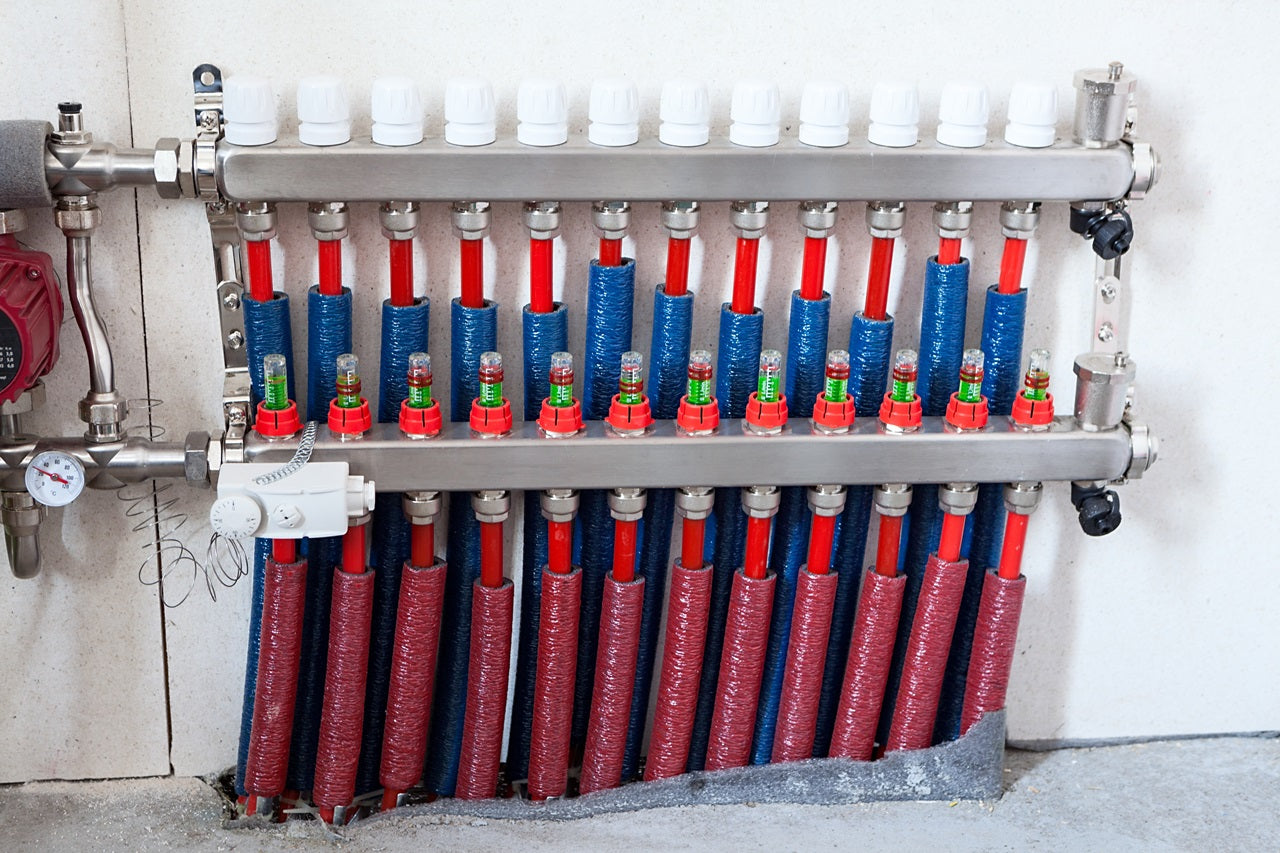Modern homes prioritize comfort and energy efficiency, so they increasingly incorporate radiant heat manifolds into their heating systems. These components help distribute heat evenly, improving performance while reducing energy waste. Whether renovating an existing space or designing a new build, integrating a radiant heat manifold can enhance overall heating efficiency and user control. Below, we explore their role in modern home design, key installation considerations, and how they complement sanitary heating and cooling systems.
The Role of Radiant Heat Manifolds in Home Heating
A radiant heat manifold is a central component of hydronic heating systems. It distributes warm water from a boiler to different heating zones, ensuring even temperature control. The ability to fine-tune heating in specific areas enhances comfort and energy efficiency.
Discover our most popular product categories – find what you need today!
- Air to Water Heat Exchangers
- Water to Air Heat Exchangers
- Plate Heat Exchangers
- Oil Coolers & Intercoolers
- Tankless Water Heaters
Key Benefits:
- Zoned Heating Control – Adjust temperatures independently in different rooms.
- Improved Energy Efficiency – Reduces heat loss by circulating warm water effectively.
- Better Comfort Levels – Evenly distributes heat across floors and spaces.
- Compatibility – Works with various floor heating systems, including tile, wood, and carpet.
With the growing demand for high-performance heating, radiant heat manifolds are essential to modern home installations.
Choosing the Right Radiant Heat Manifold for Your Home
Selecting the appropriate radiant heat manifold depends on home size, heating zones, and water supply. Here are some important considerations:
- Material – Manifolds are typically made from brass, stainless steel, or composite materials, each offering different levels of durability and performance.
- Number of Zones – Larger homes require multiple zones, while smaller homes may function well with a single manifold.
- Flow Control Features – Models with adjustable flow meters offer better customization of heat distribution.
- Installation Type – Some are designed for wall-mounted installations, while others fit into compact cabinets for a discreet look.
Understanding these factors ensures the selected manifold meets heating needs efficiently.
Integrating Radiant Heat Manifolds with Smart Home Technology
Many modern heating systems integrate with smart home automation. This lets homeowners control radiant heat manifolds via mobile apps or digital thermostats.
Smart Features to Consider:
- Remote Temperature Control – Adjust heat settings from a smartphone.
- Programmable Schedules – Set specific heating times for different rooms.
- Energy Usage Tracking – Monitor energy consumption for better efficiency.
- Voice Command Compatibility – Works with smart assistants for hands-free adjustments.
Integrating these features improves heating efficiency and user convenience, making modern homes more comfortable and cost-effective.
The Connection Between Radiant Heating and Sanitary Heating and Cooling
A well-designed heating system considers home comfort and sanitary heating and cooling solutions. Combining a radiant heat manifold with sanitary systems improves indoor air quality and energy performance.
Benefits of This Integration:
- Efficient Heat Distribution – Radiant heat works well alongside sanitary systems to maintain stable indoor temperatures.
- Reduced Air Circulation Issues – Unlike forced-air systems, radiant heating reduces airborne allergens and dust.
- Lower Operating Costs – Hydronic heating and sanitary heating and cooling can improve efficiency and reduce expenses over time.
By combining these systems, homeowners achieve a balanced and sustainable indoor climate.
Installation and Maintenance Considerations
Proper installation ensures long-term performance and efficiency of radiant heat manifolds. Here’s what to keep in mind:
Installation Tips:
- Ensure Correct Pipe Sizing – Properly sized pipes maintain efficient water flow.
- Position the Manifold Strategically – Install it in an accessible yet discreet location.
- Use Quality Insulation – Insulated pipes prevent heat loss and improve system efficiency.
- Test the System Before Sealing Floors – Always check for leaks and proper functionality before finishing flooring installations.
Maintenance Best Practices:
- Regularly Check for Leaks – Even minor leaks can reduce efficiency.
- Clean Components Periodically – Prevents buildup and ensures smooth water circulation.
- Monitor Pressure and Flow Rates – Adjust settings to maintain balanced heating.
- Schedule Professional Inspections – Annual maintenance helps identify and resolve issues early.
A well-maintained system extends the lifespan of heating components and ensures reliable performance.
Why Radiant Heat Manifolds Are an Ideal Choice for Modern Homes
As homes become more energy-conscious, radiant heat manifolds provide an effective and efficient heating solution. They offer precise temperature control, reduce energy waste, and integrate seamlessly with sanitary heating and cooling systems.
Key Takeaways:
- Improved Comfort – Even heat distribution eliminates cold spots.
- Energy Savings – Optimized water flow reduces unnecessary heating costs.
- Smart Compatibility – Integration with home automation enhances convenience.
- Healthier Indoor Air – Reduces the need for air circulation, minimizing allergens.
By incorporating these systems, homeowners can create a comfortable, cost-effective heating solution tailored to modern living.

